DRAG RACING AND DRUG TESTING
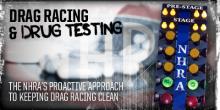 cover at the flick of a light switch. When a magazine, internet or otherwise, comes asking about drugs, a wall tighter than the Berlin Wall which separated East from West, Communism from Capitalism, can go up in the snap of a finger.
cover at the flick of a light switch. When a magazine, internet or otherwise, comes asking about drugs, a wall tighter than the Berlin Wall which separated East from West, Communism from Capitalism, can go up in the snap of a finger.The world of drag racing is as vulnerable to the use of drugs as any other venue on this planet. Yet, we found the world of drag racing is as proactive at preventing the hideous influx of drugs into the sport as any other sport in the country.
Could more be done? Yes. Are current testing policies effective? Yes.
Drugs.

A single word made up of five letters which can send most individuals scurrying into the shadows faster than cockroaches running for cover at the flick of a light switch. When a magazine, internet or otherwise, comes asking about drugs, a wall tighter than the Berlin Wall which separated East from West, Communism from Capitalism, can go up in the snap of a finger.
The world of drag racing is as vulnerable to the use of drugs as any other venue on this planet. Yet, we found the world of drag racing is as proactive at preventing the hideous influx of drugs into the sport as any other sport in the country.
Could more be done? Yes. Are current testing policies effective? Yes.
There are a multitude of drug testing policies which affect teams involved in the NHRA. The sanctioning body has a policy, the federal government has a policy, the individual teams have a policy and businesses owned by participants on the circuit have their own policies. That's a lot of coverage.
Testing is the single most important deterrent available in the campaign to maintain the clean image NHRA drag racing rightfully deserves. Due to the nature of the sport, testing comes from a variety of different bodies, the least of which is the United States government.
The Department of Transportation’s (DOT) rule, 49 CFR Part 40, describes required procedures for conducting workplace drug and alcohol testing for the Federally regulated transportation industry. Those regulations go beyond the inferred truck driver and also includes individuals operating safety-sensitive vehicles, such as a fork lift.
Teams on the NHRA circuit, falling under DOT rule 49CFR Part 40, must randomly test at least 50 percent of their workforce who operate “safety sensitive” equipment for illegal drug use and 10 percent of that same workforce for alcohol abuse.
We test at hello. You can't work for this race team if you fail a drug test. And, that's at hire. At hello. - Bob Tasca, III, owner/driver of the Quick Lane/Motorcraft Shelby Mustang, when asked if his racing operation had a drug testing policy.
a d v e r t i s e m e n t
Click to visit our sponsor's website
“They (DOT rules) affect anyone that drives safety sensitive equipment, which includes anyone with a CDL (commercial drivers license) that drives our big trucks and trailers, obviously a CDL now applies to most any commercial vehicle, so the show car drivers and so forth are applicable,” explained Mike Lewis, Senior Vice President at Schumacher Racing. “And, there's a random testing policy in effect where an agency that we contract with comes out at an unannounced period of time, we'll draw several names and people will be tested and so forth.
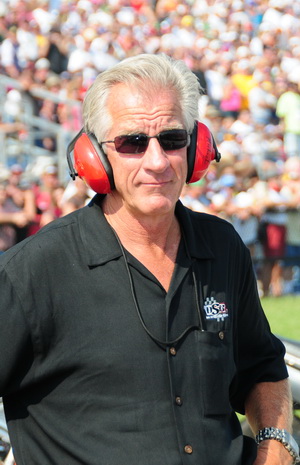 Before Mike Lewis stepped into his role as General Manager at Don Schumacher Racing, he served a stint as a Vice President of NHRA. Lewis was there when the NHRA enacted their policy.
Before Mike Lewis stepped into his role as General Manager at Don Schumacher Racing, he served a stint as a Vice President of NHRA. Lewis was there when the NHRA enacted their policy.From where he stands, the sport doesn't just look clean, it is clean.
“I think it is,” replied Lewis, the question of is the NHRA clean on the table. “I worked for NHRA as a vice-president when the drug policy was put into effect. And I wasn't directly responsible for the implementation of the policy, but I was responsible for being part of the competition committee when that policy was put into effect. So I understand what they've done, why they've done it, and I think they've done it as well as any other motor sports organization. And I would say that we have a much better record than certain other sports.”
Certainly better than NASCAR, which has suspended several crew members in all three of it's top divisions and one driver – Jeremy Mayfield – this year alone. When it comes to the NHRA and it's drug policy, the NASCAR policy is always the one mention when it comes to comparisons. In fact, there are many differences for a variety of reason, all very reasonable when explained.
“Someone that's not qualified to operate a fork lift can not only injure themselves, but also cause injury to other people. And that goes beyond, just like the CDL goes, I mean the drug and alcohol testing is only a small part of the DOT testing policy. It has to do with understanding the equipment, understanding the operation and repair of the equipment, reaction of the equipment to adverse conditions, all of those kinds of things, that require testing and a physical examination of those things. And the same thing, I mean our forklift policy, you don't have to go out and get a physical exam, but you do have to go through some training and it's not that difficult, but at the same time its a refresher for those of us, I've got one, I've got my forklift license.”
Holding a forklift license means Lewis is eligible for random testing.
A quick survey across Nitro Alley revealed teams take the Federal mandate serious, as does the sanctioning body. The repercussions from an on the road incident involving a member of the safety safari and illegal drugs or alcohol abuse could be disastrous for the sanctioning body and destroy decades of building a solid reputation for safety. The NHRA “Safety Safari” has long been held up as the standard in the motorsports because of their record of quick response and dependable service in the course of an accident or track maintenance during an event.
“We test at hello,” said Bob Tasca, III, owner/driver of the Quick Lane/Motorcraft Shelby Mustang, when asked if his racing operation had a drug testing policy. “You can't work for this race team if you fail a drug test. And, that's at hire. At hello.”
The same goes for Don Schumacher Racing, with very minor exceptions.
“There are times where we may be on the road and short an employee and we may not test them the day that they're hired, but they're eligible for testing immediately,” Lewis explained, when asked further about immediate testing of a new hire.
For the drivers in the NHRA's top divisions, Top Fuel, Funny Car, Pro Stock and Pro Stock Motorcycle, the biggest concern is the man, or woman, in the next lane. All told they spend anywhere from 4 to 8 seconds coursing down a 1000' to 1320' ribbon of concrete and asphalt. However, those are the most critical seconds in a driver's, or in the case of the Pro Stock Motorcycle – a rider's, life when it comes to an absolute need for safety.
a d v e r t i s e m e n t
Click to visit our sponsor's website
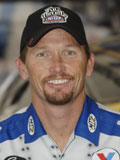 No one escapes life without physical problems. Jack Beckman, in a quite visible way, battled cancer. John Force fought to come back from a life-threatening accident two years ago in Ennis, Texas. And, Beckman and Force are not alone. There are others on the circuit who for whatever ails them take over the counter medications or medications prescribed by a doctor. They take drugs, but they take them to secure a certain quality of life and/or for life itself.
No one escapes life without physical problems. Jack Beckman, in a quite visible way, battled cancer. John Force fought to come back from a life-threatening accident two years ago in Ennis, Texas. And, Beckman and Force are not alone. There are others on the circuit who for whatever ails them take over the counter medications or medications prescribed by a doctor. They take drugs, but they take them to secure a certain quality of life and/or for life itself.Beckman's battle with cancer is well documented. He continued to race as he battled the cancer, which means he ran while the drugs were in his system, but not before he made sure there wouldn't be any issues.
“They put them in intravenously,” Beckman said when asked about the drugs he was taking while battling the cancer. “I actually checked with the doctors because I still raced during the chemotherapy. I made sure there wasn't anything that was going to conflict with the NHRA's policy.”
John Force was determined to make sure his body was squeaky
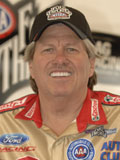 clean when he came back from his accident. “I take six different medications” he said, while sitting in his motorcoach.. “They are all meant to slow me down.”
clean when he came back from his accident. “I take six different medications” he said, while sitting in his motorcoach.. “They are all meant to slow me down.” Force felt the medications he was taking, similar to those any 60 year old man might take, were hurting his performance so he went to his doctors. He was right. His medications are meant to give him a better quality of life and to suspend or delay the inevitability of the ravages of the progression of life.
Those are the examples of drugs necessary for life. We take them because doctor's tell us we need to take them.
It's the other drugs – cocaine, heroin and methamphetamines to name a few – that we can chose not to consume. In the battle to keep drugs out of drag racing the war is won when an individual makes the choice to avoid drugs and avoid those who can't see the dangers.
Karen Stoffer, rider of the GEICO Powersports Suzuki, could easily be described as a fearless competitor, however, if she knew the rider in the other lane was abusing prescription drugs or doing illegal drugs, she would be afraid.
“If you knew that, yeah,” said Stoffer. “I wouldn't want to be in the lane next to anybody...you figure we go almost 200 miles an hour on these motorcycles and we're doing it in just under seven seconds. It's a very precise, focused sport. And focus I think being the key part there. You have to retain and sustain your mental focus throughout the course of the entire pass. Not only that, but then the shut down and turn off. And you know I think I'd be just as scared as driving on the street knowing somebody appeared to be under the influence of something, driving a little erratic.
“I would be very nervous and very upset, in fact I probably wouldn't keep my mouth shut about it. I'd have to, if I suspected something I would probably inquire and find out because I don't want to be down that race track with somebody who's not completely 100 percent focused or in their correct mind.”
Stoffer easily speaks for her fellow riders and drivers. No one we talked to wanted to go into a lane with the slightest of doubt about the competitor in the other lane.
NHRA policy is one of random drug testing of the drivers. The name Bob Tasca came up the weekend he won his career first Funny Car national event, the Gatornationals, at Gainesville Raceway in March of this year.
“One time,” said Tasca, adding, “At Gainesville, at the Gainesville race. It was a drug test and a breathalyzer.
“I fully support it, (the NHRA policy). In today's day and age you talk about baseball and performance enhancers. In our sport, it's life or death. If somebody on my team or if driver is under the influence, whether it is drugs or alcohol you're talking about not just killing himself, but maybe the guy next to him or a fan. It's a different attitude in our sport, I think, versus in baseball or basketball where they are looking to prevent enhanced abilities of players versus in our sport it's a life or death situation.
“There is no margin of error in our sport, as it is. Never mind when you interject a substance that can make it worse. I support whatever drug policy and testing there is.”
The key to any drug testing policy is the support of those being tested. As in NASCAR, the drivers/riders in the NHRA clearly support the testing policy. Some believe they NHRA doesn't test enough, some think they test just enough and others believe the policy should be extended to include those who don't currently fall under the policy – mainly crew members.
In the current economic climate it is difficult for teams to maintain a testing regimen that extends beyond those already covered. The NHRA faces the same issues. At some national events there can be as many as 900 drivers/riders in attendance. Factor in the crew members and the numbers easily reach 3000, maybe even 4000. Logistically trying to pick from such a pool could be a nightmare. According to Graham Light, NHRA Vice President of Competition, the feasibility of trying to keep track of thousands of crew members would be a daunting task. Additionally, the NHRA does not have an unlimited budget when it comes to testing, no sanctioning body does.
For those reasons, logistics, feasibility and economics, at this time crew members do not fall under the current testing policy. If crew members are tested it is done by the individual teams. In the future, it is possible the NHRA could include crew chiefs from the four pro divisions in the testing pool.
Tony Pedregon is an owner/driver faced with difficult economic times. He might be leading the point standings, but he is far from the front runner when it comes to generated sponsor dollars. He believes the NHRA should pick up the slack, including crew members in the equation when it comes to individuals in the testing pool. However, he wouldn't want to see the addition of crew members lessen the chances of a driver being tested.
“Crew members!” said Pedregon, as he integrated himself in to the interview with Tasca. “I've had employees that have passed but they find a way around it. Why not test them here at the track? Our lives are in their hand. We rely on our guys being 100 percent. I think the NHRA should do that. I think it would be a good thing to take that NASCAR model and implement that and test our crew guys randomly.”
a d v e r t i s e m e n t
Click to visit our sponsor's website
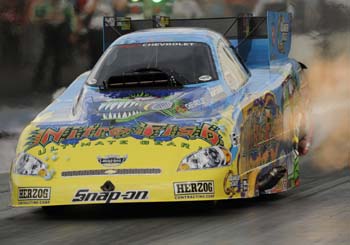
“You don't need it out there,” agreed one of the most famous drivers in all of drag racing, John Force, when asked about drug usage. Force was devastated when Eric Medlen died in one of his race cars. When he himself almost died in a wreck in Ennis, Texas, it woke Force up, in a huge way.
The night before his accident, Force had stood on the drag strip, rain pelting his face, anger in his words as he demanded a sign from God. He says the wreck was God's answer. Force says he never got hooked on the drugs that were prevalent in his youth, because “we were too poor to afford food, how were we going to buy drugs?” Alcohol was Force's drug of choice. It was legal. Almost everyone did it. But, God's message was clear, at least to Force – give up the alcohol.
“I'm done,” said Force. “It almost cost me my life. Not the alcohol. But, I realize now you need everything on race day. I've had days when I went out there, not with alcohol in me, but I had a hangover. I don't want to every face that again.
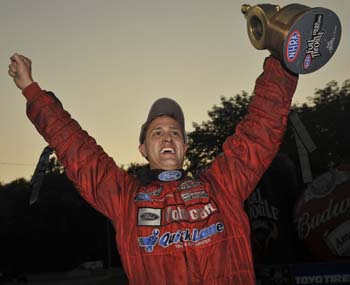
Force's message is clear. Alcohol is a drug and it can be abused the same as a drug.
The NHRA testing policy is clear, it deals not just with illegal substances, it also deals with the abuse of alcohol. When a driver/rider is tested, they are tested for illegal substances and for the presence of alcohol in their system.
Motorsports is no different than the stick and ball sports, their athletes are celebrities and as such come in contact with other celebrities who clearly have no issues with the abuse of drugs and alcohol. We read about their transgressions almost daily. The first step to keeping the sport of drag racing clean starts with the athletes. They have to say no and be the example for their friends and followers.
Tasca candidly admits he has never done any illegal drugs. There may be some who won't believe him, but his words are forceful when he says, “I have never done any illegal drugs.” Tasca goes a step further and says he would walk away from an event, function or gathering if he discovered illegal drugs were present.
Tony Pedregon admits that if he was in the same situation and it clearly could affect his ability to earn a living he would go so far as to inform the proper authorities of the problem.
a d v e r t i s e m e n t
Click to visit our sponsor's website
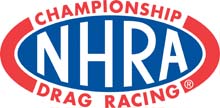 SUBSTANCE ABUSE POLICY (Ref. 2009 NHRA Rulebook, pgs 28-31, sec 1.7)
SUBSTANCE ABUSE POLICY (Ref. 2009 NHRA Rulebook, pgs 28-31, sec 1.7)Enhancing the safety and integrity of NHRA drag racing is of paramount concern to the National Hot Rod Association (NHRA). Substance abuse is fundamentally inconsistent with increased safety and with the integrity of a drag racing program. Accordingly, NHRA has established this Substance Abuse Policy.
NASCAR testing is far more extensive than that done by the NHRA. NASCAR tests for over 5,000 banned substances and test far more individuals on a weekly basis than does the NHRA. That is to be expected. To date, NASCAR has caught more than a dozen crew members and one driver. On the NHRA side of the fence, no driver has ever been suspended or banned for the use of illegal drugs or alcohol.
Look if you want and if you dig deep enough, if you tempt enough, you'll find someone, on some team, at some drag strip who will succumb to the lure of illegal drugs. Unfortunately, that is human nature. What you'll also find are huge group of men and women determined to keep their sport as clean as humanly possible with the same veracity that goes into building motorcycles, sedans, funny cars and dragsters which offer a thrill far greater but no less addictive than any drug.
Before Mike Lewis stepped into his role as Senior Vice President at Don Schumacher Racing, he served a stint as a Vice President of NHRA. Lewis was there when the NHRA enacted their policy.
From where he stands, the sport doesn't just look clean, it is clean.
“I think it is,” replied Lewis, the question of is the NHRA clean on the table. “I worked for NHRA as a vice-president when the drug policy was put into effect. And I wasn't directly responsible for the implementation of the policy, but I was responsible for being part of the competition committee when that policy was put into effect. So I understand what they've done, why they've done it, and I think they've done it as well as any other motor sports organization. And I would say that we have a much better record than certain other sports.”
Certainly better than NASCAR, which has suspended several crew members in all three of it's top divisions and one driver – Jeremy Mayfield – this year alone. When it comes to the NHRA and it's drug policy, the NASCAR policy is always the one mention when it comes to comparisons. In fact, there are many differences for a variety of reason, all very reasonable when explained.
There really is no reason to compare the NHRA policy to those of football, baseball, basketball, hockey, soccer and other professional sports. Even the amateur sports such as swimming and cycling are such different animals, there is no reason to compare them to the NHRA.
Drag racing is unique. Performance enhancing drugs have very little value in a 4 second battle down a 1000foot, or 1320 foot, strip of concrete or asphalt. The bigger concern is the illegal use of “recreational drugs”, the abuse of prescription drugs and the abuse of alcohol. Those are the primary concerns of the NHRA, as seen by those that make up the show.
“I think NHRA has done a great job in identifying or ruling out from competition any one that's relying on drugs or alcohol and they have some in their system,” said Lewis. “They've done a good job of maintaining confidence.”
Confidence to a race car driving is everything. They must have confidence in themselves, the machine they drive and the driver in the lane next to them.
What is also needed is fairness and compassion. The stewards of the sport don't want drugs involved in the sport, but they understand the human element involved. It is not the intention of the rule book to punish an individual with the harshest possible penalty on a first offense. In fact, a driver could test positive for a banned substance, go through rehab and the NHRA offices would never be the wiser. Get caught a second time and no one can save you from being removed from the sport, permanently.
Why the initial leniency?
“There are legal issues dealing with personal privacy,” said Lewis. “There are legal issues dealing with somebody's career and advancement of their career and so forth. There were some notable exceptions that were very public, you know the Darrel Alderman case was very public, and that was not based on personal use of a product, but of distribution of product and admission to a felony. Different story.
“But, I think that privacy is a key part of all of this, and I think the focus is on two things, one is making sure that we don't subject fans, other drivers and so forth, to individuals in control of dangerous equipment who are not of sound presence of mind. That's number one. And two is identifying at an early stage anything, minor infractions, single use infractions, hangovers...things like that can show up in these drug tests. (You) give the individual a chance to clean themselves, learn from the experience.”
| {loadposition feedback} |





